Themed collection RSC Sustainability Hot Papers

A greener prescription: the power of natural organic materials in healthcare
Natural organic materials might offer a sustainable solution at the crossroads of technological progress and environmental degradation.

RSC Sustainability, 2024,2, 2190-2198
https://doi.org/10.1039/D4SU00219A
The relevance of sustainable laboratory practices
Traditional lab practices contribute to environmental issues through excessive energy consumption, hazardous- and single-use waste generation, and resource depletion. Sustainable laboratory practices are vital for the education of future scientists.

RSC Sustainability, 2024,2, 1300-1336
https://doi.org/10.1039/D4SU00056K
Exploring metal oxides for the hydrogen evolution reaction (HER) in the field of nanotechnology
As the global energy landscape transitions towards a more diversified mix, with electricity and hydrogen constituting half of the final energy consumption by 2050, the focus on efficient and sustainable hydrogen production intensifies.
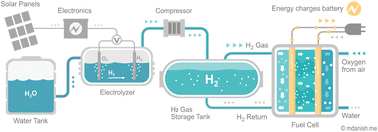
RSC Sustainability, 2023,1, 2180-2196
https://doi.org/10.1039/D3SU00179B
Chemistry and pathways to net zero for sustainability
Chemistry has a vital role in enabling the reductions in greenhouse gases, stewardship of material resources and new production processes needed to bring net CO2 emissions to zero by 2050, keeping within 1.5 °C of global warming.

RSC Sustainability, 2023,1, 1704-1721
https://doi.org/10.1039/D3SU00125C
White & grey biotechnologies for shaping a sustainable future
The developments in enzymology and biocatalytic processes designed as per the rules of green chemistry and green engineering are the keys to the concepts of biorefinery and bioeconomy which in turn enable sustainable development.

RSC Sustainability, 2023,1, 1722-1736
https://doi.org/10.1039/D3SU00174A
The lignin challenge in catalytic conversion of biomass solids to chemicals and fuels
Presented here is an overview of progress in one approach to reducing greenhouse gas emission, namely substituting photosynthesis generated, woody biomass for fossil carbon as feedstock in the production of chemicals and liquid fuels.

RSC Sustainability, 2023,1, 1686-1703
https://doi.org/10.1039/D3SU00117B
A perspective on catalytic production of olefinic compounds from biomass
Key reactions and possible biomass resources for the synthesis of industrially important unsaturated compounds are summarized.

RSC Sustainability, 2023,1, 814-837
https://doi.org/10.1039/D3SU00033H
Unlocking the holy grail of sustainable and scalable mesoporous silica using computational modelling
Enabling the design of silica materials with ordered and controllable pore structure using the principles of green and sustainable chemistry.

RSC Sustainability, 2023,1, 432-438
https://doi.org/10.1039/D3SU00019B
Status, implications and challenges of European safe and sustainable by design paradigms applicable to nanomaterials and advanced materials
Current European (EU) policies, such as the Green Deal, envisage safe and sustainable by design (SSbD) practices for the management of chemicals, which cogently entail nanomaterials (NMs) and advanced materials (AdMa).
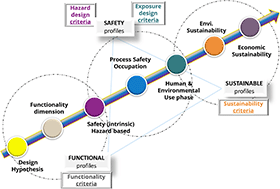
RSC Sustainability, 2023,1, 234-250
https://doi.org/10.1039/D2SU00101B
Chemical degradation of oxygenated polymers: the case of polyethers and polysiloxanes
A review of the most representative advances in the chemical degradation of polythers and polysiloxanes, both in academia and industry.

RSC Sustainability, 2024,2, 1904-1929
https://doi.org/10.1039/D4SU00093E
Sustainability-driven photocatalysis: oxygen-doped g-C3N4 for organic contaminant degradation
The unique characteristics of oxygen-doped g-C3N4 (O@g-C3N4), including enhanced charge carrier mobility and changed electronic structure, make it especially appealing for photocatalytic applications.

RSC Sustainability, 2024,2, 91-100
https://doi.org/10.1039/D3SU00384A
A guide to lignin valorization in biorefineries: traditional, recent, and forthcoming approaches to convert raw lignocellulose into valuable materials and chemicals
This tutorial review aims at providing a complete overview of the strategies for the conversion of lignocellulose in current and future biorefineries, with a particular focus on the transformation of lignin toward valuable products.
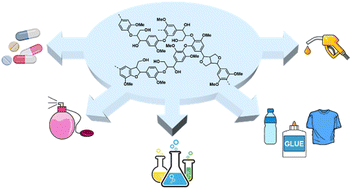
RSC Sustainability, 2024,2, 37-90
https://doi.org/10.1039/D3SU00140G
Recent advances in Cu-BTC MOF-based engineered materials for the photocatalytic treatment of pharmaceutical wastewater towards environmental remediation
Cu-MOF has gained attention due to its exceptional thermal stability, large surface area and pore volume. This review summarizes its advantages covering synthesis, reactivity and applications in removing toxic pharmaceutical residues from wastewater.

RSC Sustainability, 2023,1, 1952-1961
https://doi.org/10.1039/D3SU00276D
3D printing for flow biocatalysis
3D printing has been elaborated in all stages of a continuous flow biocatalytic process, from the reactor to the support material for biocatalyst confinement or the peripheral accessories that can establish a highly controlled process.

RSC Sustainability, 2023,1, 1672-1685
https://doi.org/10.1039/D3SU00155E
Utilizing cellulose-based conducting hydrogels in iontronics
This review highlights how the inherent properties of cellulose have been employed to improve the properties of ionic conductive hydrogels (IHCs) and their application in fabricating iontronics.

RSC Sustainability, 2023,1, 1369-1385
https://doi.org/10.1039/D3SU00139C
Recent advances in radical polymerization of bio-based monomers in aqueous dispersed media
Vegetable oils and lipids, terpenes, lignin derivatives, carbohydrates, and proteins are used as biomass feedstock to prepare new bio-based monomers for radical polymerization in aqueous dispersed media, producing bio-based latexes.

RSC Sustainability, 2023,1, 788-813
https://doi.org/10.1039/D3SU00097D
Replacing all petroleum-based chemical products with natural biomass-based chemical products: a tutorial review
Production quantity ratio of petroleum derived chemical products. This also presents the concept of replacing all petroleum-based chemical products with natural biomass-based chemical products.

RSC Sustainability, 2023,1, 179-212
https://doi.org/10.1039/D2SU00014H
2D transition metal dichalcogenides for photovoltaics, hydrogen production, and CO2 photoreduction
The transition from fossil-based to solar-based energy sources is essential to minimize greenhouse gas emissions.

RSC Sustainability, 2025,3, 4887-4910
https://doi.org/10.1039/D5SU00494B
State-of-the-art of industrial PET mechanical recycling: technologies, impact of contamination and guidelines for decision-making
A design of PET mechanical recycling at the industrial scale requires the inspection of the relevance of pre-treatment steps, degradation reactions and repair potential, accounting for the impact of contamination (e.g. NIAS) and regulations.

RSC Sustainability, 2025,3, 1996-2047
https://doi.org/10.1039/D4SU00571F
Coupling deep eutectic solvents with innovative extraction techniques towards plant derived bioactive compositions
This review outlines the evolution, current status, and future trends in utilizing DESs as extraction solvents with innovative techniques to recover valuable compounds from natural sources for diverse laboratory and industrial applications.

RSC Sustainability, 2024,2, 1675-1691
https://doi.org/10.1039/D4SU00111G
Graphitic carbon nitride (g-C3N4) as an emerging photocatalyst for sustainable environmental applications: a comprehensive review
g-C3N4: a sustainable game-changer in photocatalysis. This work explores synthesis, properties, mechanisms, and applications, addresses challenges, and charts future trends.

RSC Sustainability, 2024,2, 265-287
https://doi.org/10.1039/D3SU00382E
Eutectic solvents and low molecular weight gelators for next-generation supramolecular eutectogels: a sustainable chemistry perspective
Immobilization of eutectic mixtures in supramolecular gels formed using low molecular weight gelators is a smart strategy to expand their design space. Advances in the last five years are reviewed from the viewpoint of sustainability.

RSC Sustainability, 2024,2, 288-319
https://doi.org/10.1039/D3SU00264K
Recent advancements towards the green synthesis of carbon quantum dots as an innovative and eco-friendly solution for metal ion sensing and monitoring
An overview of the importance of green chemistry in synthesizing fluorescent carbon quantum dots as an effective tool for metal ion sensing is discussed. Various synthesis methods and mechanisms involved in metal ion sensing using CQDs are presented.

RSC Sustainability, 2024,2, 11-36
https://doi.org/10.1039/D3SU00375B
A review on polyhydroxyalkanoate (PHA) production through the use of lignocellulosic biomass
This work examines the process of using lignocellulosic biomass for cost-effective polyhydroxyalkanoate production, from pre-treatment to extraction.

RSC Sustainability, 2023,1, 2120-2134
https://doi.org/10.1039/D3SU00126A
A review on recent trends in selective hydrodeoxygenation of lignin derived molecules
A review on the selective catalytic hydrodeoxygenation of lignin biomass derived compounds. The focus is on recent reports which highlight achievements in selectively and reactivity trends which lead to deoxygenated aromatic products.

RSC Sustainability, 2023,1, 1608-1633
https://doi.org/10.1039/D3SU00232B
Towards the sustainable extraction and purification of non-animal proteins from biomass using alternative solvents
This review aims to assess the advances in protein extraction and separation from non-animal biomass using alternative solvents, namely ILs, and DESs. Also, the economic and environmental challenges of using such alternative solvents are discussed.

RSC Sustainability, 2023,1, 1314-1331
https://doi.org/10.1039/D3SU00062A
Recovery of metals and valuable chemicals from waste electric and electronic materials: a critical review of existing technologies
The growing development of technology has increased the amount of waste generated by electrical and electronic equipment (WEEE) every year.

RSC Sustainability, 2023,1, 1085-1108
https://doi.org/10.1039/D3SU00034F
A review of past promises, present realities and a vibrant future for wound dressing from naturally occurring to sustainable materials
In the contemporary world, evolution of the scientific field has reached an elevation but has its own intricacies.

RSC Sustainability, 2023,1, 763-787
https://doi.org/10.1039/D3SU00065F
Advancements in organic and inorganic shell materials for the preparation of microencapsulated phase change materials for thermal energy storage applications
The current generation is looking for new materials and technology to reduce the dependency on fossil fuels, exploring sustainable energy sources to maintain the future energy demand and supply.

RSC Sustainability, 2023,1, 665-697
https://doi.org/10.1039/D2SU00116K
Recovering spent lithium nickel manganese cobalt (NMC) oxide cathodes from Li ion batteries for use as oxygen evolution reaction electrocatalysts
Li ion battery cathode materials such as nickel manganese cobalt (NMC) oxide can be recovered from spent batteries and used directly as an electrocatalyst for the oxygen evolution reaction (OER). However, battery history plays a role in OER performance.

RSC Sustainability, 2025,3, 5459-5463
https://doi.org/10.1039/D5SU00728C
Metal recovery from ‘black mass’ of spent alkaline batteries using aqueous protic ionic liquids and deep eutectic solvents
Ionic liquids and deep eutectic solvents are presented as promising solvents for the recovery of critical metals from end-of-life batteries.

RSC Sustainability, 2025,3, 5118-5122
https://doi.org/10.1039/D5SU00737B
Copper nanoparticles decorated on cobalt oxide nanosheets derived from bimetallic metal–organic-framework for hydrolysis of ammonia borane
Cu nanoparticles decorated on CoOx nanosheets are synthesized by an in situ reduction of bimetallic Cu-Co-MOF-74 which simultaneously catalyses efficient AB hydrolysis.

RSC Sustainability, 2023,1, 1962-1966
https://doi.org/10.1039/D3SU00306J
Synthesis of platinum group metal nanoparticles assisted by CO2 reduction and H2 cogeneration at gas-diffusion electrodes
Platinum group metal nanoparticles (Pt, Pd, and Rh) were synthesized in aqueous NaCl solutions using, as reducing agent, H2/CO electrogenerated in situ by the reduction of CO2 and water.
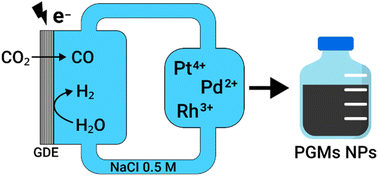
RSC Sustainability, 2023,1, 454-458
https://doi.org/10.1039/D3SU00046J
Green synthesis of jarosite nanoparticles for photocatalytic degradation of Rhodamine B under simulated sunlight radiation
This study pioneers green synthesis of jarosite nanoparticles using banana peel extract as potassium source, outperforming magnetite in photocatalytic dye degradation.

RSC Sustainability, 2025,3, 5518-5526
https://doi.org/10.1039/D5SU00731C
Pyrolysis of orange peel waste to pyrofuels and pyrochar: optimization and techno-economic insights for industrial scale-up
Biomass presents a sustainable alternative to fossil fuels; however, it faces limitations such as high moisture content, low bulk density, and poor grindability.

RSC Sustainability, 2025,3, 5527-5555
https://doi.org/10.1039/D5SU00575B
Valorisation of invasive plant (Rhododendron ponticum) biomass into activated biochar as a sustainable adsorbent for emerging pharmaceutical contaminant removal from water
The common issue of water contamination by pharmaceuticals are increasingly recognised as emerging contaminants in water as they pose significant environmental and health risks, necessitating innovative and sustainable approaches to water treatment.

RSC Sustainability, 2025,3, 5507-5517
https://doi.org/10.1039/D5SU00589B
Reuse of consumable pipette tips for large-scale trace analysis of contaminants of emerging concern in wastewater
This study shows that solvent-based washing enables safe pipette tip reuse for trace chemical analysis, with EtOH : H2O (50 : 50, v/v) providing the best balance of cleaning, and sustainability, reducing plastic waste without performance loss.

RSC Sustainability, 2025,3, 5470-5485
https://doi.org/10.1039/D5SU00644A
Sustainable conductive ink for printing high performance wearable sensors
Printing combined temperature and relative humidity sensors on fabrics and other surfaces by flexography and screen printing with a sustainable conductive organic ink.

RSC Sustainability, 2026, Advance Article
https://doi.org/10.1039/D5SU00582E
Selective separation of critical metals from lithium-ion batteries in a two-phase leaching system based on a hydrophobic deep eutectic solvent and H2O2 solution
A two-phase system using a hydrophobic deep eutectic solvent (2 mol of 4,4,4-trifluoro-1-(2-thienyl)-1,3-butanedione: 1 mol tri-n-octylphosphine oxide) and H2O2 enabled selective recovery of Li, Co, Ni, and Mn from spent lithium-ion batteries.

RSC Sustainability, 2026, Advance Article
https://doi.org/10.1039/D5SU00657K
Visible-light-induced decarboxylative acylation of unsaturated hydrocarbons with α-oxocarboxylic acid via Csp2–Csp2 cross-coupling: a facile access to chalcones
We describe an efficient strategy for synthesizing chalcones via photocatalytic decarboxylative cross-acyl coupling of α-oxocarboxylic acid with styrene under visible light irradiation as a sustainable energy input.

RSC Sustainability, 2025,3, 5176-5181
https://doi.org/10.1039/D5SU00684H
Bioconversion of self-neutralized chemically depolymerized lignin streams into polyhydroxyalkanoates
Combined lignin-derived streams enable microbial synthesis of biodegradable polymers, advancing integrated chemo-biological routes toward scalable and cost-effective bioplastic production.

RSC Sustainability, 2025,3, 5136-5145
https://doi.org/10.1039/D5SU00563A
Biobased chemical recycling: aminolysis of PET using renewable reagents and monomers to synthesize new semi-aromatic polyamides
Aminolysis of PET using renewable reagents enables the synthesis new semi-aromatic polyamides.

RSC Sustainability, 2025,3, 5155-5166
https://doi.org/10.1039/D5SU00547G
Green synthesis of spiro-barbiturates: advancing sustainable chemistry and drug design research
Through this research, we have established an environmentally friendly and sustainable approach for the synthesis of spirobarbiturate (SB) derivatives, which hold significant potential in the field of medicinal chemistry.

RSC Sustainability, 2025,3, 5167-5175
https://doi.org/10.1039/D5SU00343A
Using ultrasonic oil–water nano-emulsions to purify lithium-ion battery black mass
Long-loop recycling of spent lithium-ion batteries is neither sustainable nor economical at scale.

RSC Sustainability, 2025,3, 1516-1523
https://doi.org/10.1039/D4SU00771A
Carbon removal efficiency and energy requirement of engineered carbon removal technologies
We conduct a harmonized lifecycle greenhouse gas assessment to compare the carbon removal efficiency and total energy required for twelve engineered carbon removal technologies.

RSC Sustainability, 2025,3, 1424-1433
https://doi.org/10.1039/D4SU00552J
Exploration of lignin-binding synthetic polymers with pendant hydrophobic amino acids
Polymers bearing hydrophobic amino acid moieties were synthesized, and their binding affinities with wood lignin were investigated. The polymers bearing tryptophan and phenylalanine moieties were observed to exhibit high binding affinity.

RSC Sustainability, 2025,3, 875-880
https://doi.org/10.1039/D4SU00433G
Expanded polystyrene is not chemically degraded by mealworms
Expanded polystyrene (EPS) is a widely used plastic material that poses significant environmental challenges due to its resistance to degradation.

RSC Sustainability, 2025,3, 383-394
https://doi.org/10.1039/D4SU00618F
Recovery of graphite from industrial lithium-ion battery black mass
A streamlined workflow is established for the recovery of graphite from industrial lithium-ion battery black mass, which could be seamlessly integrated into the existing cathode materials recycling processes developed in the industry.

RSC Sustainability, 2025,3, 264-274
https://doi.org/10.1039/D4SU00427B
Supramolecular purification of aromatic polyester monomers from chemical depolymerization
The separation and recovery of PET monomers from chemical recycling is demonstrated with the use of supramolecular binding.

RSC Sustainability, 2024,2, 3879-3887
https://doi.org/10.1039/D4SU00330F
Ammonia-free synthesis of lithium manganese iron phosphate cathodes via a co-precipitation reaction
A novel precursor phase (Mn, Fe)5(PO4)2(HPO4)2·4H2O is introduced with a co-precipitation reaction, enabling a low-cost, sustainable, scalable production of LMFP cathodes exhibiting excellent cycling stability with good tap density.

RSC Sustainability, 2024,2, 1969-1978
https://doi.org/10.1039/D4SU00125G
Halogen-free bleaching of shellac using electrochemically generated peroxodicarbonate
A halogen-free bleaching of shellac was developed using electrochemically generated peroxodicarbonate with acetonitrile as an activator. A reduced bleaching damage is obtained compared to previous halogen-free bleaching reports.

RSC Sustainability, 2024,2, 1963-1968
https://doi.org/10.1039/D4SU00228H
The sustainability onion: a panoramic view of a parent concept, its paths, and progeny
This study presents a comprehensive sustainability framework, showing the concept's different sides or perspectives and its derivatives.

RSC Sustainability, 2024,2, 1948-1962
https://doi.org/10.1039/D3SU00361B
Yeast-laden hydrogel capsules for scalable trace lead removal from water
Hydrogel capsules are used to encapsulate yeast for the scalable and efficient removal of trace lead from water.

RSC Sustainability, 2024,2, 1761-1772
https://doi.org/10.1039/D4SU00052H
Upcycling of lithium cobalt oxide to LiNi1/3Mn1/3Co1/3O2
Upcycling of lithium cobalt oxide (LCO) into lithium nickel manganese cobalt oxide (NMC111) cathode material using acetone antisolvent crystallization of citrate leachate followed by sol–gel synthesis with complementary metal acetate or sulfate salts.

RSC Sustainability, 2024,2, 1773-1781
https://doi.org/10.1039/D4SU00131A
The role of FAIR nanosafety data and nanoinformatics in achieving the UN sustainable development goals: the NanoCommons experience
Increasingly Findable, Accessible, Reusable and Interoperable (FAIR) nanomaterials environmental health and safety (nanoEHS) data and demoncratised access to nanoinformatics models will directly support 12 SDGs and indireclty benefit the other 5 SDGs.

RSC Sustainability, 2024,2, 1378-1399
https://doi.org/10.1039/D3SU00148B
Ultra-fast extraction of metals from a printed circuit board using high power ultrasound in a calcium chloride-based deep eutectic solvent
The increase of digitization, alongside the growth in consumer electronics and shortened life cycles, has led to a significant global increase in the volume of electronic waste (e-waste).

RSC Sustainability, 2024,2, 403-415
https://doi.org/10.1039/D3SU00147D
Evolving sustainable energy technologies and assessments through global research networks: advancing the role of blue hydrogen for a cleaner future
Unveiling the potential of blue hydrogen: empowering global research networks for a sustainable energy evolution.

RSC Sustainability, 2024,2, 348-368
https://doi.org/10.1039/D3SU00309D
An improved Hummers method derived graphene oxide wrapped ZIF-8 polyhedron derived porous heterostructure for symmetric supercapacitor performance
By exposing more interfaces, utility of heterostructured electrodes in capacitance retention has been further expanded to devices with a large-scale 3D network. IGO@ZIF-8-NC was described as a symmetric supercapacitor device which paves the way forward for sustainable capacitive devices.

RSC Sustainability, 2024,2, 233-238
https://doi.org/10.1039/D3SU00327B
Recovery of palladium from waste fashion items through food waste by-products
We propose an affordable and safe route to recover palladium in its metallic form from waste fashion items and recycle it in electronic devices.

RSC Sustainability, 2023,1, 2350-2357
https://doi.org/10.1039/D3SU00242J
The heat-promoted metal–support interaction of a PtCu/SiO2 carbon-free catalyst for the methanol oxidation and oxygen reduction reactions
Pt shows excellent catalytic activity towards the methanol oxidation reaction (MOR) and oxygen reduction reaction (ORR), but suffers from deactivation due to the weak interaction with the carbon support and the oxidation of carbon.

RSC Sustainability, 2023,1, 1989-1994
https://doi.org/10.1039/D3SU00193H
Visible-light driven fumarate synthesis from pyruvate and gaseous CO2 with a hybrid system of photocatalytic NADH regeneration and dual biocatalysts
Visible-light driven fumarate synthesis from pyruvate and gaseous CO2 with a hybrid system of photocatalytic NADH regeneration and dual biocatalysts (malate dehydrogenase and fumarase) was developed.

RSC Sustainability, 2023,1, 1874-1882
https://doi.org/10.1039/D3SU00194F
Exploration of bis(pentafluorophenyl)borinic acid as an electronically saturated, bench-top stable Lewis acid catalyst
Bis(pentafluorophenyl)borinic acid was investigated as a bench-stable Lewis acid catalyst for the hydrosilyation of carbonyl functionalities. The reactivity was benchmarked to other effective frustrated Lewis pair catalysts.

RSC Sustainability, 2023,1, 1547-1553
https://doi.org/10.1039/D3SU00222E
Effective photocatalytic degradation of rhodamine-B over Zn-doped BaO2 and SrO2 composites under UV and sunlight irradiation
Environmental pollution due to dye industries is a major concern as it affects both aquatic and human life.

RSC Sustainability, 2023,1, 1511-1521
https://doi.org/10.1039/D3SU00091E
Catalyzing sustainability: phytic acid as a green precursor for metal-free carbon electrocatalysts in ORR
Phytic acid (PA) carbonization at 900 °C produces P-doped carbons with outstanding ORR electrocatalytic activity, highlighting the potential of PA-derived carbon materials in energy conversion.

RSC Sustainability, 2023,1, 1270-1277
https://doi.org/10.1039/D3SU00119A
An integrated green process for the extraction of triterpenic acids from Eucalyptus globulus leaves after hydrodistillation
An integrated process using Eucalyptus globulus essential oil as a bio-based solvent to extract triterpenic acids from hydrodistilled leaves is discussed.

RSC Sustainability, 2023,1, 1016-1024
https://doi.org/10.1039/D3SU00076A
Flow-through reductive catalytic fractionation of beech wood sawdust
The use of flow-through (FT) systems in the lignin-first approach can improve the proficiency of the process. Herein, the reductive catalytic fractionation of beech wood sawdust was conducted in an FT system using 35Ni/NDC pellets.

RSC Sustainability, 2023,1, 459-469
https://doi.org/10.1039/D2SU00076H
Supercritical carbon dioxide/nitrogen/air extraction with multistage stripping enables selective recovery of rare earth elements from coal fly ashes
Using supercritical fluids, our novel process selectively extracts rare earth elements from coal fly ashes that were previously considered as waste and an environmental threat.
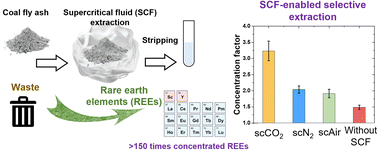
RSC Sustainability, 2023,1, 251-260
https://doi.org/10.1039/D2SU00033D
Sustainable and efficient production of furoic acid from furfural through amine assisted oxidation with hydrogen peroxide and its implementation for the synthesis of alkyl furoate
Furan based building blocks have potential of introducing new commodity chemicals at low cost with low carbon impact.

RSC Sustainability, 2023,1, 303-309
https://doi.org/10.1039/D2SU00102K
Functionalised graphite felt anodes for enhanced power generation in membrane-less soil microbial fuel cells
Testing composite carbon-based anode materials for high-perfoming soil microbial fuel cells.

RSC Sustainability, 2023,1, 310-325
https://doi.org/10.1039/D2SU00079B
About this collection
We are delighted to highlight some of the most impactful and significant work published in RSC Sustainability. These papers are already beginning to shape and influence the future direction of the field.